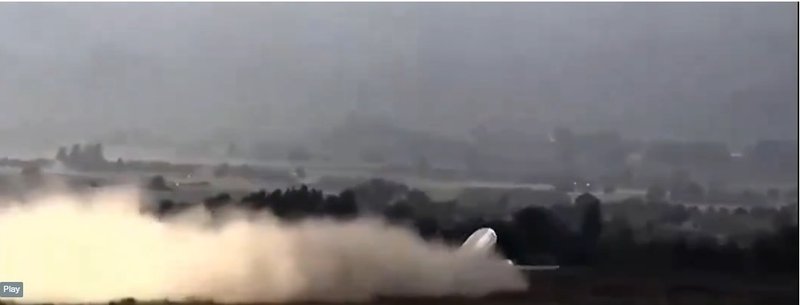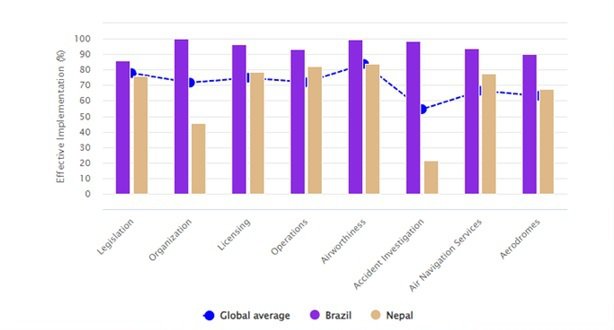There is never a dull day in aviation and not all with sad endings as we generally dread. There may be some minor incidents happening at some airports right now, like a service vehicle hitting the engine cowl of a jet, a soft collusion between jets with wing tip of one tearing off the horizontal stabilizer of another or a fuel tanker getting stuck under the wings and occasional big and small tail strikes. Even minor aircraft repairs costs a fortune. Just about a week ago there was a serious incident involving an Ariana jet throwing a dust storm as the B737 overran runway at Khost (KHT) as its rear rubbed against the terrain. Thankfully, it still managed to get airborne even after tearing the perimeter fence. A month ago a Brazilian airline had a rather long tail strike that indented the runway at Milan by over 700m. A day earlier two Saudi B777s has soft collision during pushback at Riyadh damaging nose of one and tail of another. It would have been much cheaper to employ wing walkers during pushbacks in crowded space than bear aircraft groundings topped by expensive repairs.
But it was, by far, more humiliating to learn about Nepali ground technician trying locally available “super glue” on having inadvertently tinkered with a perfectly function hydraulic line of an A320. Personally, I am skeptical about the given details. But, we can very well imagine the panic that must have set in, making the person act in the way he did. Further, this act exposes an extreme laxity on the part of the aircraft repair team for not being (1) careful enough to identify the line that needed maintenance and (2) not following proper repair procedures as laid. Earning such blemish is a disgrace that Nepal aviation could do without.

Ariana B737 throwing heavy dust as it overran runway
We do not know what the Afghan authorities did, but the Italy's civil aviation safety investigation authority has released its preliminary report on the B777 tail strike incident. The investigation has since determined that ‘pilots made a critical error when inputting data into the on board computer which led the plane's computer to calculate an incorrect take off speed, significantly lower than what was necessary leading to tail strike. Such reports are issued within thirty days following the incident, but in our case, here, neither the Saury’s crash investigating team nor CAAN, for that matter, has uttered a word about it as the deadline overran. So much for claims of taking safety in aviation very “seriously”!
Strangely, citing anonymous investigating team source Bizmandu.com had a story on 11 August claiming that “unsecured” maintenance kits (probably implying heavy load of tools) as having caused the imbalanced. Ascertaining the center of gravity (CG) of a loaded aircraft is a critical aspect, and it is more so when not fully loaded. Normally, a loadmaster does the planning of the correct placement of the load on the airplane and ensures that cargos are secured firmly. The final load distribution sheet of the aircraft is presented to the captain for approval by ensuring it is loaded within its safe CG limits. But we would not know if the story was accurate enough as there was no follow up story beyond the “probable” leak.
While the initial assumption was about thrust imbalance arising out of a failed engine as the possible reason. But with hindsight, an aircraft with engines mounted at the rear, closer to body, then hung under wings, the resulting imbalance would be comparatively less. It is so, because of reduced distance (lever arm) between the source of thrust (engines) and aircraft CG. But again, we need to await the release of the official version to know what did exactly happen.
In my previous piece (The rot overhead) I had dealt about Yeti’s Pokhra crash and an extremely casual manner the upgradation flight was executed. Following which someone mailed me a copy of EASA team’s report of 11-15 September 2023 follow up visit. Besides mentioning other drawbacks, it also highlighted one related to “CAAN’s current practices in personnel licensing requirements and flight examiner systems. It showed non-compliance with international safety standards, especially as regards examiner designations in the area of flight crew licensing.
It further suggested that the need for CAAN to establish clear criteria, privileges, and effective surveillance mechanisms for Designated Check Pilots and examiners. Implementing these measures will significantly enhance the safety and competency standards across the aviation sector in Nepal, ensuring a more consistent and reliable oversight of aviation professionals. Sadly, given the above observation, it is not surprising that the Pokhara crash happened the way it did.

Lastly, CAAN boasts about Nepal having attained a better average in ICAO/USOAP (Universal Safety Oversight Audit Programme). Just compare the graph relating to “accident investigation” (6th col) against “effective implementation” and we see Brazil’s stood at colossal 98.5% (2023)and despite that it had an ATR crash with 62 fatalities this August. And Nepal with a dismal 21.69% (2022) starkly reveals where the problem lies. May be it is just a joke that describes how a statistician who calculated that the “average depth” of all the rivers of the world was just 1.20m. He then confidentially stepped into a river and drowned! Wonder if CAAN is not heading the same way by trumping up the “average” agenda?
There is no way forward without sealing the gaping hole in the rickety boat with which we are making an attempt to cross the unforgiving ocean. Making a clean break and creating an exclusive and permanent aviation regulatory body is the only answer.
- No Wonder, Its Mad March
- Mar 12, 2025
- The Pinhole Image
- Feb 04, 2025
- The Rot Overhead
- Aug 03, 2024
- Tailwind Or No Tailwind
- Mar 18, 2024
- The Knockout Punch : Pokhara Crash Investigation Report
- Jan 05, 2024















